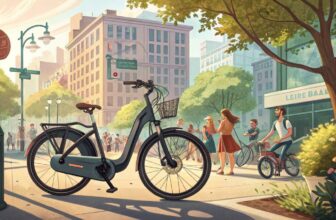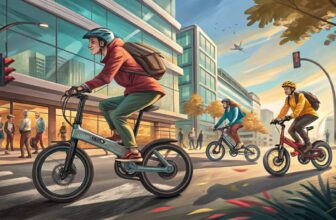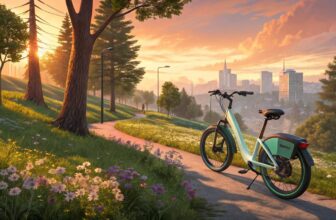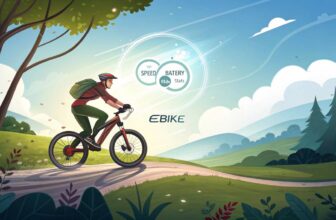Understanding E-Bike Motors
If you’ve ever thought about electric bikes and how they zip around, you’ve probably wondered what makes them tick. Here’s a friendly scoop on the essentials: torque and wattage.
Motor Torque Explained
Okay, so torque is all about how strong your bike’s push is. You can think of it like the grunt that gets your bike going, especially when facing those pesky hills. It’s measured in Newton meters (Nm). Picture it as the muscle behind the bike’s motion. The bigger the number, the stronger the bike picks up speed and tackles steeper paths.
Most e-bikes brag about torque from 50 to 60 Nm, but some beefed-up versions go up to 80 Nm. This comes in super handy when riding over rocky trails on electric mountain bikes.
| E-Bike Model | Torque (Nm) |
|---|---|
| Standard E-Bike | 50-60 |
| High-Torque E-Bike | 80 |
Those numbers become your best buddy when you’re aiming for quick zips or steep climbs.
Motor Wattage Overview
Now, onto wattage—it’s about how much juice the motor can crank out. Measured in watts (W), wattage tells you how much oomph the motor is transforming into riding power. What surprises you is that wattage isn’t just one number. It’s got two stars: continuous power, the steady kind, and peak power, which is that burst of extra energy for when you need a quick punch.
Most e-bikes have engines with constant power cruising between 250 and 300 watts. Need more giddy-up? The peak power kicks in, letting you take off faster or tackle those hills like a pro.
| Power Rating | Continuous Power (W) | Peak Power (W) |
|---|---|---|
| Standard E-Bike | 250-300 | Skyscraping in surges |
| High-Performance E-Bike | 350+ | Goes even higher |
When it comes to rules of the road, the power level says a ton. Want the inside scoop? Check out the legal chapter in our electric bike laws section.
Getting the hang of torque and wattage helps you pick the perfect e-bike, whether you’re all about city rides, and trails, or just want something powerful for an afternoon joyride. For a peek at the nitty-gritty of motor types, we’ve got you covered with our exhaustively exciting ebike motor types guide.
Why Torque Matters on E-Bikes
Picture torque as the muscle behind your e-bike’s performance. Measured in Newton-metres (Nm), it’s like the secret sauce that makes every uphill ride and speedy getaway smooth.
Torque for Uphill Riding
When climbing a hill feels like a breeze, you can thank torque. High- torque motors are powerhouses, giving your e-bike the grunt needed to conquer inclines without breaking a sweat. Most e-bikes rock a 50-60 Nm range, but heavy hitters like the MeloYelo Traverse pack a punch with 80 Nm (MeloYelo).
| E-Bike Model | Torque (Nm) |
|---|---|
| Standard E-Bike | 50-60 |
| MeloYelo Traverse | 80 |
| MeloYelo Ascent | 80 |
| MeloYelo Superlite | 80 |
High-torque is a game-changer, especially if you’ve got bags to haul or just like your uphill rides to feel as smooth as a hot knife through butter. This feature is a favorite among delivery folks and those city slickers who want their commute to be a breeze.
Acceleration and Torque
Want to zip through traffic like a breeze or weave through city streets without breaking a sweat? Torque’s got your back. High-torque motors offer speedy take-off, a plus for both fitness buffs looking to break a sweat and seniors searching for a little extra zip.
Take a gander at how torque amps up performance:
| Torque (Nm) | Effect on Performance |
|---|---|
| 50-60 | Decent acceleration |
| 80+ | Zippy acceleration, perfect for hills |
Pairing a high-torque motor with peak power can turn any ride into a thrilling adventure. No more hard pedaling, just smooth sailing across town—with the occasional uphill climb.
Getting a grip on torque and how it revs up your e-bike’s game can help when you’re squaring off between e-bike models. Whether you’re eyeing a weekend cruiser or a daily road warrior, understanding torque might just make you feel like an electric bike genius. If you’re keen to keep your ride in tip-top shape, swing by our electric bike maintenance guide.
Types of E-Bike Motors
Electric bikes come in all shapes and sizes, and their motors are just as varied. Each motor type offers its perks, ready to boost your ride. Curious about what makes them tick? Let’s get into mid-drive motors and high torque engines.
Mid-Drive Motor Placement
Mid-drive motors like hanging out in the bike’s belly, right in the center, making the most of their spot. Why? Well, it makes the bike ride smoother and more balanced:
- Weight Balance for Days: With the motor smack-dab in the middle, your bike feels grounded. This balance is your best buddy when riding over rocky paths or zipping through town.
- Power to the Pedals: Mid-drive motors pack a punch directly into the crankshaft. They crank up the torque, especially when you’re scaling those monster hills. They’re a mountain biker’s dream.
- Juice Saver: These guys use the bike’s natural gears smartly, squeezing every last drop out of the battery for longer rides.
Popular Mid-Drive Motors
Check out some of the crowd favorites:
| Model | Torque (Nm) | Power (W) |
|---|---|---|
| Bafang MaxDrive | 80 | 792 |
| Bosch Performance CX | 85 | 600 |
| Yamaha PWseries | 80 | 500 |
Want more details? Dive into the mid-drive vs. hub motor ebike guide for the full scoop.
High Torque Motors
These motors are the heavy hitters, designed to muscle through the toughest trails and heaviest loads. They’re all about getting you through the sticky spots with a little help from your friend—high torque:
- Tackle Anything: Off-road adventures and those crazy steep paths won’t know what hit them with high torque motors backing you up (BikeRadar).
- Speed Boost: They give your bike a kick in the rear, making acceleration a breeze and keeping response times sharp.
Notable High Torque Motors
Here’s who to look out for in the high torque world:
| Model | Torque (Nm) | Power (W) |
|---|---|---|
| FREY AM1000 V6 | 160 | 1500 |
| Brose Drive S Mag | 90 | 760 |
| Shimano EP8 | 85 | 500 |
Take FREY AM1000 V6 for a spin—it kicks up to 1500 watts and 160 Nm of torque, making it feel like you’re on a lightweight dirt bike (GearJunkie). The Bafang MaxDrive also gets a nod for making hills feel a little less like Everest, putting out 80 Nm of torque.
Knowing how mid-drive and high torque motors stack up helps you pick the right e-bike. If you’re into finesse and balance, go for mid-drive. If power is your game, crank up the high torque. And while you’re at it, make sure to dig into electric bike battery care, ebike range factors, and electric bike maintenance—we’ve got your back with our full guides.
Exploring Motor Power in E-Bikes
Seriously, if you’re diving into the e-bike world, you gotta know your motor power because it pretty much decides how your ride rolls. We’re talkin’ watts, baby! Those little buggers tell you how fast you can go up a hill or zoom across flat ground.
Watts and Their Role
So, what the heck are watts anyway? Simply put, they’re all about how much electrical juice your e-bike motor turns into that sweet, sweet mechanical power. Normally, e-bike motors come with two important watt numbers: continuous power and peak power.
- Continuous Power: Think of this as your motor’s chill mode. It’s how much power the motor can keep dishing out without breaking a sweat. Most e-bikes sit around 250 to 300 watts in this category. For folks in places like New Zealand, 300 watts is the max you can legally ride with on roads. More watts mean better cruising on flat surfaces and gentle slopes.
- Peak Power: This is where your motor lets loose for short bursts of awesomeness. You get peak power by cranking up both voltage and amps. The MaxDrive motor from Bafang? It’s packin’ 792 watts of peak power, letting you burn rubber and tackle hills like a pro.
| Motor Power Type | Output (Watts) | Use Case |
|---|---|---|
| Continuous Power | 250-300 | Easy breezy rides, gentle hills |
| Peak Power | 600-800 | Go power for uphill stretches, speedy starts |
Peak Power Benefits
When your route’s got more peaks than a birthday cake, you want top-notch peak power. It’s what helps your e-bike do the heavy lifting on challenging roads.
- Hill Climbing: Extra peak power gives your ride that extra oomph to conquer steep slopes without making your legs feel like jelly.
- Quick Bursts: City riders and delivery folks love peak power ’cause it lets ’em blast off from a standstill or bob and weave through traffic.
E-bikes with more torque and peak power make life on two wheels a breeze, stealthily handling anything from city dodges to hardcore mountain jaunts. Match up those specs with where and how you like to ride.
Want more motor mojo? Check out our rundown on ebike motor types.
And if you’re hungry for even more e-bike savvy, explore ebike range factors and electric bike power ratings.
Torque vs. Cadence Sensors
Figuring out the differences between torque and cadence sensors is a game-changer for picking the right sensor for your e-bike. They each bring their own perks to the table, catering to various riding styles and needs.
Torque Sensor Functionality
Torque sensors are like your best biking buddy—they boost the motor’s power based on how hard you’re pedaling. This makes the ride feel smooth and natural like you’re practically flying along the road with superhuman strength. If you’re all about that authentic riding vibe, torque sensors make your bike feel like an extension of you.
| Feature | Torque Sensor |
|---|---|
| Power Adjustment | Depends on pedaling effort |
| Ride Experience | Smooth and natural |
| Battery Life | Better longevity |
| Suitable For | Hilly areas, fitness buffs |
These sensors are great for those hilly paths where a bit of extra push comes in handy. Your pace and the terrain are like friends catching up over coffee, adjusting and adapting to each other seamlessly.
If you’re unsure about the best bits and bobs for your e-bike, our ebike gear systems guide has got your back.
Cadence Sensor Functionality
Cadence sensors are the “get up and go” type. They switch on the motor as soon as the pedals start turning, no matter how laidback or fast-paced you are. It’s an easy ride with a fast start but can feel a bit choppy, like trying to find the right station on an old radio. And yup, it might drain that battery quicker.
| Feature | Cadence Sensor |
|---|---|
| Power Adjustment | Based on pedal motion |
| Ride Experience | Zippy with a touch of choppiness |
| Battery Life | Less efficient |
| Suitable For | Chill rides, city jaunts |
If you’re up for laid-back cruising or zipping through town, these sensors are your go-to. They make bike rides less about the workout and more about the good times. Keeping in time with the local speed laws might be tricky, but hey, it’s all about that balance, right?
For the nitty-gritty on how e-bike parts stack up, our electric bike power rating guide might be just what you need.
Grasping the vibes of both torque and cadence sensors will point you toward the one that fits your riding style like a glove. Peek into our electric bike maintenance guide for tips on keeping your ride in tip-top condition.
Pros and Cons of Cadence Sensors
Cadence sensors play a big role in a lot of e-bikes, especially for folks looking for an easy and budget-friendly way to get into powered cycling. Let’s check out the highs and lows of using cadence sensors on your ride.
Smooth Acceleration
So how do cadence sensors work? They kick the electric motor into gear when the pedals start moving, and it doesn’t matter how fast or hard you’re pedaling. This makes acceleration smooth as butter:
- Easy Ride: The minute you start pedaling, the motor jumps in. It’s like having a magic carpet ride with hardly any effort.
- User-Friendly: Great for seniors wanting to move around easily and getting to work quickly, these bikes make it super easy for just about anyone to hop on and go.
| Sensor Type | Acceleration | Ease of Use | User Experience |
|---|---|---|---|
| Cadence Sensor | Smooth | Very Easy | Responsive and Quick |
| Torque Sensor | Gradual | Moderate | Natural and Adaptive |
Speed Limit Challenges
Now, it ain’t all sunshine and roses. Cadence sensors can throw up a couple of speed bumps, especially when it comes to keeping speed in check:
- Jerky Movements: They can be a bit jumpy sometimes, particularly when you’re just crawling along. It might feel a bit like trying to ride a bucking bronco instead of a steady cruiser.
- Battery Life: Since they keep the motor going without worrying about how much you’re putting into the pedaling, they can suck the battery dry quicker, meaning fewer miles before needing a charge.
| Drawbacks | Impact |
|---|---|
| Jerky Movements | Less smooth at low speeds |
| Reduced Battery Life | Shorter riding range |
In short, cadence sensors are a pretty straightforward and effective choice for many riders, but it’s good to think over these ups and downs based on how you roll. If you want to get more into the nitty-gritty about these parts and how they change your ride, check out our guides on ebike motor types and ebike gear systems.
Benefits of Torque Sensors
Torque sensors are the unsung heroes for e-bike fans, making every ride feel like a dream. Whether you’re zipping through city streets or taking a leisurely ride through the park, they’ve got you covered.
Natural Riding Experience
Got an itch for a smooth bike ride? Torque sensors tune the motor power based on how hard you’re pedaling, giving you a seamless ride that’s just like, if not better than, a regular bicycle. The power boost feels like you’re channeling a bit of superhero might, making every ride both fun and comfy.
And the cherry on top? Torque sensors usually extend your e-bike’s battery life. They dish out just the right amount of juice depending on your input, which is great news for city commuters or those planning the mega ride across town. Wanna know how to keep your e-bike battery in top shape? Check out our guide on electric bike battery care.
| Feature | Cadence Sensor | Torque Sensor |
|---|---|---|
| Power Delivery | Constant | Proportional |
| Battery Efficiency | Lower | Higher |
| Riding Experience | Less Natural | More Natural |
| Energy Usage | Higher | Efficient |
Adaptive Riding on Various Terrains
Thinking of hitting those bumpy roads or hilly terrains? Torque sensors are your trusty sidekick. They read the room, or in this case, the road, reacting to how hard you’re pedaling and adjusting accordingly. They’re lifesavers on steep slopes or uneven paths, delivering that extra push when needed.
High-torque motors take the sweat out of climbing hills, especially when you’re on a hefty e-bike or lugging around some weight, keeping the ride smooth. Most e-bikes pack around 50-60 Newton meters (Nm) of torque, but some beasts can go up to 80 Nm, letting you tackle those hills with ease
For those who love taking the road less traveled, the flexibility torque sensors provide is a game changer. Want more tips on getting the most from your e-bike? Peek at our post on ebike gear systems.
Choosing an e-bike with torque sensors means anyone—city commuter, workout buff, or those needing a little extra help—can enjoy a pleasant, adaptive, and efficient ride. For even more tips and tricks, check out our guide on mid-drive vs hub motor ebike.
Choosing the Right Sensor
Picking just the right gadget for your e-bike can boost your ride from “meh” to “heck yeah!” Let’s chat about what to think about and what gizmo fits different biking actions.
Factors to Consider
Riding Terrain
- Climbing Mountains: Always feel like you’re on a permanent uphill battle? Torque bits have got your back. They kick in the power just when you need it, so climbing doesn’t feel like you’re lugging a boulder uphill.
- Cruising the Flats: For those who enjoy the easy, breezy rides, cadence sensors are your pal. They keep the power steady—no need for heavy leg work here.
Riding Style
- Chillin’ on Wheels: For the easy-going rider, cadence sensors deliver a nice, smooth glide—think Sunday afternoon cruise.
- Speed Demons: Torque sensors are for folks who like to feel the wind in their hair. They adjust like magic to keep you zooming along.
Budget
- Penny Pinching: Want something simple and won’t empty your pocket? Cadence sensors fit the bill.
- Ready to Splurge: If you’re down to dish out a bit more cash for a seamless ride, torque gadgets might be your calling.
| Factor | Why Torque is Great | Why Cadence Rocks |
|---|---|---|
| Terrain | Boss of hills | Friend of the flats |
| Ride Style | For your need for speed | For the chill crowd |
| Cash Flow | More bucks | More for your buck |
Ideal Sensor for Different Riding Styles
City Sashay (Urban Commuters)
Those city streets can be wild—stop lights and all. With cadence sensors, you can scoot off quick without a hitch. Ideal for those hustling in the hustle and bustle. Check out more city smarts in our ebike commuting guide.
Green Warriors (Eco-Conscious Consumers)
Want your ride to save the Earth and your battery? Torque sensors, adjusting power based on your muscle power, make sure every watt counts. Curious for more tips? Peek into our electric bike battery care.
Gym Buff on Wheels (Fitness Enthusiasts)
Wanna feel like you’re pedaling on old-school two-wheelers? Torque sensors push you to pedal strong, keeping that heart pumping. Get the scoop on why they’re great for your workout at ebike exercise benefits.
Smooth Riders (Seniors Seeking Mobility)
For our senior pals, cadence sensors are the bomb. They make rides gentle and predictable, with less heavy breathing. Dive into options at electric bikes for seniors.
Speedy Deliveries (Delivery Service Providers)
Surging through traffic with stop-and-go moments? Cadence sensors keep the power coming just right, especially when every second counts. Want more? Check our delivery ebike guide.
Just for Fun (Recreation Riders)
Weekend cruisers, hear this: Either sensor can jazz up your joyrides. For a simple ride, cadence’s your friend, but torque sensors pitch in when paths get trickier.
Picking the right gadget is all about what you need, where you bike, and what weighs down on your wallet. With the 411 on these factors, zooming into the perfect sensor becomes a breeze. Craving more nuggets on e-bikes? Check articles on electric bike maintenance and e-bike troubleshooting.




